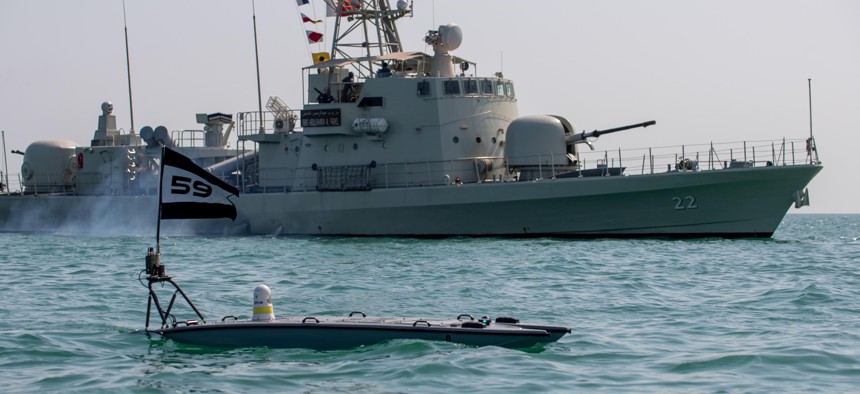
A U.S. MANTAS T-12 unmanned surface vessel, front, operates alongside Royal Bahrain Naval Force fast-attack craft RBNS Abdul Rahman Al-fadel, during exercise New Horizon in the Persian Gulf, Oct. 26, 2021. U.S. Navy Petty Officer 2nd Class Dawson Roth
Iran’s Attempted Drone Thefts Highlight Challenges of Protecting Unmanned Vessels at Sea
Navy may minimally-man some vessels to provide security, CNO says.
The U.S. Navy managed to retrieve a trio of unmanned vessels from Iranian would-be thieves recently, but the incidents highlight the need to protect maritime drones that may in the future be valuable, armed, or sensitive.
In the span of a week, Iranian forces tried to steal U.S. unmanned surface vessels in the Persian Gulf and Red Sea, and in both instances U.S. helicopters and ships stopped the Iranians and retrieved the drones. The 5th Fleet’s Task Force 59 is using these Saildrone Explorers as part of its experimentation into how to incorporate unmanned vessels into fleet operations.
Military experts who spoke to Defense One were unsurprised by Iran’s attempts to steal the drones, based on previous unprofessional behavior in the region, including unsafe maneuvers near ships and the detention of U.S. sailors in 2016. Iran also has a history of capturing or shooting down American aerial drones and trying to reverse-engineer them.
This was also not the first time that a U.S. naval drone has been captured. In 2016, China took an “ocean glider,” an underwater drone that was being used by an oceanographic ship in international waters near the Philippines. China returned the drone several days later.
As this technology becomes more prevalent at sea, the Navy will need to consider how it will respond in similar circumstances. The recent incidents with Iran and the Navy’s experimental task force raised some of those questions in this “real-world test,” said Peter Singer, a strategist at New America and author of “Ghost Fleet.”
“What do you do if an adversary harasses your system or even tries to take them? What are your best responses? What are the lines that are uncrossable, crossable, etc.,” he said. “With a future system you may have [classified systems], and so you're going to have to work out like why I'd want to protect them. But then there's the ‘Okay, how do I ensure if I lose the system, that the enemy doesn't get any kind of advantage from it?”
Chief of Naval Operations Adm. Mike Gilday appeared to agree with that sentiment Wednesday, saying the Navy is learning from what is happening to these drones.
“Well, we did have a response plan and we actually put it into effect when the Iranians grabbed two of those Saildrones,” Gilday said. “That is going to be a challenge for us though, I will say, in the future...We’re learning from what happened over the past month in the Middle East and we’ll be applying that as we design and grow” the unmanned surface fleet.
Gilday said the Navy might make larger unmanned vessels “initially minimally manned” and part of a group of ships like a carrier strike group or an amphibious ready group, “so they wouldn’t be out there alone and unafraid, if you will.”
In a statement to Defense One, a Navy official said the service follows international law in the operation of all its platforms at sea, “including the obligation to operate with due regard for the rights of other states. We expect other nations to do the same. Our policy and procedures for defending unmanned systems against unlawful uses of force are the same as those applicable to defending any U.S. property at sea.”
If the Navy wants to use their drones, especially spread out across large distances, they will have to accept that some will be lost, said Bryan Clark, a senior fellow at the Hudson Institute.
“If you were looking at this in the Indo-Pacific, you know, if this was the South China Sea, then these Saildrones would be operating far enough away where you wouldn't be able to get to them before the Chinese can take them and drag them off to one of their islands or back home to China,” Clark said. “So it seems like you try to operate in a more distributed manner, if you really want to exploit these vehicles, you're going to have to accept the fact that they are going to periodically get captured or lost.”
Perhaps some of the bigger questions to contend with in the future of unmanned technology is not the drones themselves but the actions of humans, Singer said.
“Like how much of this is actually a technology problem and how much of it is certain states just not respecting the norms of behavior at sea, and us not having a good response for it, whether it's manned or unmanned,” he said.
The Navy’s plans for unmanned systems include larger, more military-specific vessels than the Saildrones, ones that have sensitive or classified sensors and communication systems for gathering and sharing data to warships, or that are armed with advanced missiles. The recent Rim of the Pacific exercise included experiments with some large unmanned surface ships.
One of the ways the Navy can protect the technology on the drones is to have tamper-resistant features that would disable hardware or erase software to ensure no one could use important parts, Clark said. However, the person probably would still be able to get at the basic drone functions like its engine.
Another way may be to place sailors on the larger drone ships for periods of time to defend it if a warship is not close enough to respond, Clark said.
“Because otherwise they just sort of take up a destroyer guarding an unmanned vessel, as opposed to letting the destroyer do its job,” he said.
Bradley Peniston contributed to this report.




